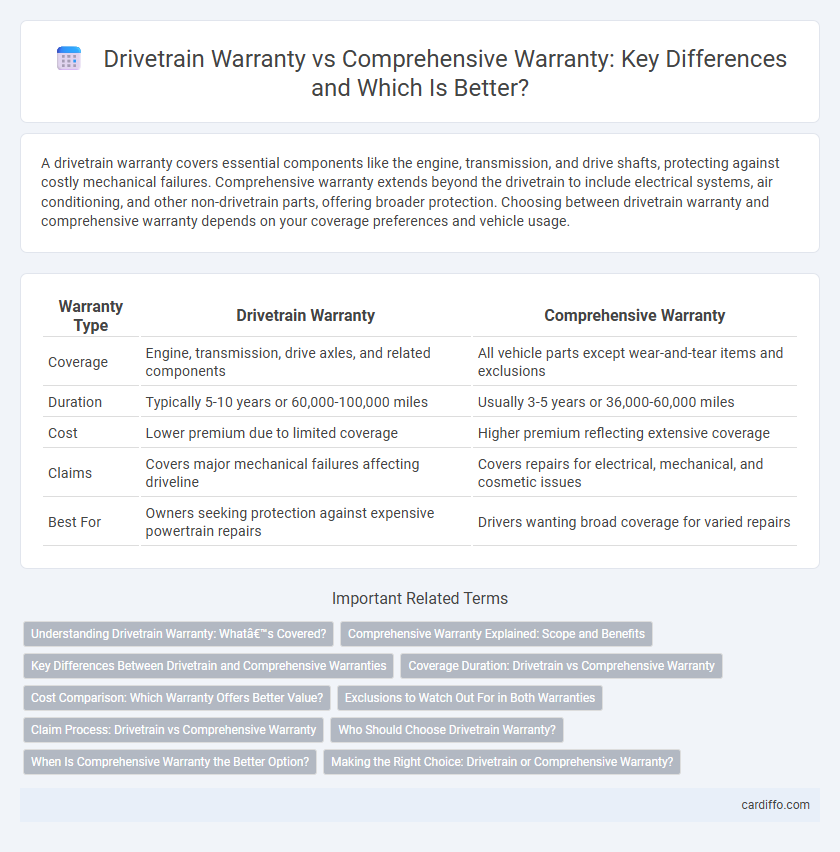A drivetrain warranty covers essential components like the engine, transmission, and drive shafts, protecting against costly mechanical failures. Comprehensive warranty extends beyond the drivetrain to include electrical systems, air conditioning, and other non-drivetrain parts, offering broader protection. Choosing between drivetrain warranty and comprehensive warranty depends on your coverage preferences and vehicle usage.
Table of Comparison
| Warranty Type | Drivetrain Warranty | Comprehensive Warranty |
|---|---|---|
| Coverage | Engine, transmission, drive axles, and related components | All vehicle parts except wear-and-tear items and exclusions |
| Duration | Typically 5-10 years or 60,000-100,000 miles | Usually 3-5 years or 36,000-60,000 miles |
| Cost | Lower premium due to limited coverage | Higher premium reflecting extensive coverage |
| Claims | Covers major mechanical failures affecting driveline | Covers repairs for electrical, mechanical, and cosmetic issues |
| Best For | Owners seeking protection against expensive powertrain repairs | Drivers wanting broad coverage for varied repairs |
Understanding Drivetrain Warranty: What’s Covered?
Drivetrain warranty specifically covers critical components such as the engine, transmission, driveshafts, and differentials, ensuring protection against mechanical failures related to these parts. This type of warranty excludes coverage for non-drivetrain parts like electronics, air conditioning, and suspension systems, which are typically included in a comprehensive warranty. Understanding the scope of drivetrain warranty helps vehicle owners focus on essential repairs while recognizing the broader protection offered by comprehensive warranty plans.
Comprehensive Warranty Explained: Scope and Benefits
Comprehensive Warranty covers a wide range of vehicle components beyond the drivetrain, including electrical systems, air conditioning, and interior features, providing broader protection. This type of warranty reduces out-of-pocket repair costs by addressing unexpected mechanical failures and cosmetic issues that are not related to the engine or transmission. Customers benefit from enhanced peace of mind and increased vehicle resale value due to the extensive coverage offered by comprehensive plans.
Key Differences Between Drivetrain and Comprehensive Warranties
Drivetrain warranty covers essential components such as the engine, transmission, and driveshaft, focusing on protecting major mechanical parts responsible for vehicle movement. Comprehensive warranty offers broader protection, including coverage for electrical systems, air conditioning, and other non-drivetrain parts, addressing a wider range of repairs and maintenance. The key difference lies in scope: drivetrain warranty targets core mechanical failures while comprehensive warranty ensures extensive coverage across multiple vehicle systems.
Coverage Duration: Drivetrain vs Comprehensive Warranty
Drivetrain warranties typically cover critical components like the engine, transmission, and drivetrain for a longer duration, often ranging from 5 to 10 years or 60,000 to 100,000 miles. Comprehensive warranties usually have shorter coverage periods, commonly lasting 3 years or 36,000 miles, and protect a broader range of vehicle parts beyond the drivetrain. Understanding the distinct coverage durations helps consumers make informed decisions based on their vehicle maintenance priorities and anticipated ownership length.
Cost Comparison: Which Warranty Offers Better Value?
Drivetrain warranties typically cost less upfront than comprehensive warranties, focusing coverage on critical components like the engine, transmission, and drivetrain system. Comprehensive warranties, while more expensive, cover a broader range of repairs including electrical systems, air conditioning, and even minor parts, potentially reducing out-of-pocket expenses over time. Choosing between the two depends on the vehicle's age, reliability, and the owner's budget, but comprehensive warranties often provide better long-term value despite higher initial costs.
Exclusions to Watch Out For in Both Warranties
Drivetrain warranties often exclude coverage for wear-and-tear components such as brakes, tires, and suspension parts, focusing solely on the engine, transmission, and drivetrain components. Comprehensive warranties tend to cover a broader range of repairs but commonly exclude damage caused by accidents, misuse, or lack of proper maintenance. Understanding these exclusions is crucial to avoid unexpected out-of-pocket expenses despite having warranty coverage.
Claim Process: Drivetrain vs Comprehensive Warranty
The drivetrain warranty claim process typically requires verifying issues related to key components like the transmission, driveshaft, and axles, often involving specialized diagnostic tests to confirm coverage. Comprehensive warranty claims encompass a broader range of repairs, including electrical, mechanical, and cosmetic defects, necessitating detailed documentation and sometimes multiple service visits to address diverse issues. Both warranties mandate proof of regular maintenance and authorized service records to validate claims and ensure eligibility.
Who Should Choose Drivetrain Warranty?
Drivetrain warranty is ideal for drivers who plan to keep their vehicles for an extended period and want to cover the essential components such as the engine, transmission, and axle system. It suits budget-conscious consumers seeking protection against costly repairs related specifically to the vehicle's powertrain without paying for broader coverage. Those using their vehicles primarily for commuting or light-duty tasks benefit most from drivetrain warranties, as these typically exclude wear-and-tear items covered under comprehensive plans.
When Is Comprehensive Warranty the Better Option?
Comprehensive warranty is the better option when you seek coverage beyond the drivetrain, including electrical systems, suspension, and exterior damage, providing broader protection against unexpected repairs. It is ideal for vehicles with higher mileage or those used in varied driving conditions where non-drivetrain components are more prone to failure. Drivers who want peace of mind from costly repairs on multiple vehicle systems benefit the most from comprehensive warranty plans.
Making the Right Choice: Drivetrain or Comprehensive Warranty?
Choosing between drivetrain warranty and comprehensive warranty hinges on your vehicle usage and risk tolerance; drivetrain coverage focuses solely on essential components like the engine, transmission, and driveshaft, offering cost-effective protection against major repairs. Comprehensive warranty extends to nearly all vehicle parts, including electrical systems and interior features, providing broader security but often at a higher premium. Evaluating factors such as vehicle age, maintenance habits, and potential repair costs ensures selecting the most suitable protection for long-term savings and peace of mind.
Drivetrain Warranty vs Comprehensive Warranty Infographic

 cardiffo.com
cardiffo.com